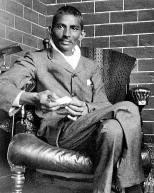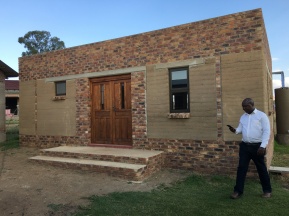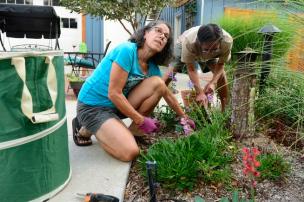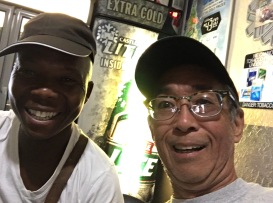Everyone thinks of changing the world, but no one thinks of changing himself – Leo Tolstoy


Be the change you wish to see in the world – Mohandas Gandhi

I followed Gandhi’s strategy for as long as I could. There came a point in our struggle when the brute force of the oppressor could no longer be countered through passive resistance alone … We chose sabotage because it did not involve the loss of life, and it offered the best hope for future race relations. – Nelson Mandela
****************************
When I cleared customs in Chicago, the Homeland Security guy was more interested in how my visit to South Africa went than the packaged beef Biltong – potential contraband – I had in my bag.

Biltong is sliced spiced meat, similar to jerky. Click on the image and check out my pilot episode about my South Africa impressions.
My research resulted in a “pilot” travelogue of my recent trip to South Africa. You can check it out here.
When I was in South Africa, the latest news was about the unearthing of a new hominid’s remains – Homo naledi – in a South African cave. South Africa is one of the first places on earth occupied by humans.
That was 300,000 years ago.

The British defeated the Dutch who trekked north, but encountered local resistance to the Zulu tribe who were eventually surrendered.
I’m investigating a third story for the “Aging Gratefully” documentary series about the connection among cultural traditions, aging and the role of a community in native and non-native cultures.
Little did I know that Mohandas Gandhi might have been South Africa’s most controversial immigrant.
Gandhi’s work later inspired Nelson Mandela.
Come to find out, Gandhi formed a couple intentional communities in his efforts to improve life for Indian immigrants in the early 20th century.

The Phoenix community near Durban was purchased by Gandhi.
Later, he partnered with a Johannesburg farm owner and formed the Tolstoy community named after the Russian author who was also his friend and colleague.
Jews, Muslims, Christians and Hindus lived and worked together in Tolstoy to eliminate discriminatory practices against other minority immigrant groups.
That brings me to my story about the possibilities of melding traditional community customs and rituals around multi-generational care for elders into contemporary indigenous society.
To check things out, my travels took me to an intentional community development effort in South Africa called Memel Global, which is also the site of a organic community permaculture garden.Not knowing what to expect, I tagged along with my neighbor and Memel Global project architect Bryan Bowen of Caddis Architects and his colleagues, Jamison and Molly.
They are working with Steven Ablondi and his wife Cindy Burns as they develop their project in the town of Memel and the township of Zamani in the Free State Province of South Africa. Steven and I are friends and colleagues on the National Cohousing Association board.
South African communities generally consist of towns like Memel, which under apartheid were inhabited by the white minority.

Memel Global constructed some “rammed earth” houses in Zamani.
Township homes have been government provided since the 1950s. That practice continues today.
Memel Global first focused on the SheWins non-governmental organization that empowers women and girls to transform their communities and meet their social needs.

Marley Hauser works with the SheWins soccer program.
Marley Hauser, a volunteer from Vermont, originally arrived to be a soccer coach. In the “other duties as assigned” category, she’s helping develop a sanitary napkin manufacturing process for SheWins. The plan is to fill a community need and at the same time employ some people. The unemployment rate is at least 50 percent.
Memel Global is involved in a wide-ranging list of projects from housing for families and the elderly to while supporting health to primary education to sports programs to the arts.

Shakes Mafanela works with the SheWins track team
Shakes was also my guide for a couple days. I was interested in township life and he showed me around Zamani and Soweto.
Memel Global has a wide-ranging mission. I’ve initially narrowed the scope of one documentary project down to community building and cohousing that taps into tribal culture and family traditions.

Pieter Lombaard is a fellow filmmaker documenting Memel Global with Mark and Bright.
He has been documenting Memel Global for the past couple years. Currently, he also is working to get artists to come to Memel, set up residencies and teach skills to local aspiring artists – painters, musicians, dancers.
I couldn’t have picked a more complex place than South Africa, but there’s a huge need for affordable housing.
The housing patterns made 50 years ago exist today. After apartheid, the government constructed township housing with the good intention of improving living conditions.
Even though separations based on race are technically no more, the reality is, South African society is separate but equal based on social and economic class.
Township residents are trapped with no other housing options since they can’t develop any equity.
Like Native Americans on reservations, township members don’t own their land but rather it is held “in trust” by the government.
In the United States, it is possible for tribes and tribal members to take their land out of trust status, which is counter-productive because they give up their sovereignty rights to the surrounding state and federal governments.
In South Africa, there are isolated pilot programs like one in Capetown that re-appropriates land to the occupier. Memel Global is working with the Memel town government to build housing on some of the uninhabited urban plots.
In my way of thinking, the path of least resistance would be to create a pilot project. A group of culturally related families would organize themselves into a community and jointly purchase the site. An outside funder – likely donors – could then finance and help the community construct the homes and common spaces. There could be a variety of ways. and combinations to deed land to the occupiers; swap property from government ownership elsewhere to the Memel site.
Why culturally related?
Having worked extensively with Native American tribes – particularly the Northern Arapaho – I am aware of the importance of ritual and clanship and how those define contemporary communities and physical territory. At one level, the Northern Arapaho Tribe governs for the common good, but at a deeper level, there are clan and spiritual overlays that cause conflicts and not apparent to the outside observer.

This Zamani resident would like to upgrade her housing, but can’t because the government owns the land.
When asked whether she would move into a new community. She said she had other relatives who would move to Zamani and live in a community but only if members consisted of her family members. There could be a larger community of many clan-based subcommunities. This was the traditional social pattern before tribes and families were dispersed during apartheid.
The traditional way of living for South African tribal members is not only tribal based, but also family based. This is evident in the township housing design. The plot of land is fairly large. On it is a main building that has a living area and a master bedroom and bath and in some cases a kitchen.
In the back is generally a detached accessory dwelling unit that has three rooms. The uses vary from bedrooms, to a kitchen, to office space depending on family needs at any particular moment. There is detached water source and toilet. As for this Zamani family, there is an open space behind the house where the family performs rituals.

In Soweto, one of the accessory dwelling rooms by the one I stayed as a guest was converted into a traditional medicine doctor’s office.
Deteriorating housing and an inability to keep up with demand remain unintended legacies of apartheid more than 20 years after former President Nelson Mandela’s African National Congress came to power after the nation’s first multiracial vote.
Since that time approximately 4 million homes have been built by the national government. That may seem like a lot, but construction has not been able to keep pace with demand from an ever-growing population in both the rural and urban areas.
Unauthorized settlements are spring up near towns and townships, including the informal community of Foster near Memel and Zamani by settlers unwilling to wait for the government to get around to providing promised housing.
In 1994, the housing backlog was nearly 1.5 million. The need has swelled to well over 2 million as the population has grown by over 13-million people.
The middle class also victims of the housing crunch.
There are 15% of South Africa’s 15 million households earn enough to secure a private mortgage, but difficult to secure because the land can’t be collateralized.
About 60% earn less than R3500 or $270 per month and qualify for government housing. But because of the construction waiting list, those homes won’t be constructed anytime soon.
The middle class makes up 25% and includes law enforcement officers, health care providers, educators and the military. They fall between the cracks because they earn too little to qualify for bank financing and make too much to qualify for government housing. This group would be a good market for the intentional community pilot project.
How might cohousing help South Africa meet its housing gap?

Lindy Cook and Alan O’Hashi pull weeds from the garden of the community with other residents at Silver Sage Village. The active adult cohousing community for those 55 or older is setup like a usual condo community with every person having their own place, but the sense of community is what is unique. (Photo By Brent Lewis/The Denver Post)
Cohousing community members are usually unrelated and may or may not share common values or rituals. That’s typical in American society that emphasizes pulling oneself up by their bootstraps and keeping to one’s self.
Cohousing, in a sense, pounds rugged individualism square pegs into community-based round holes.
Cohousing created around South African cultural norms may be a way to bring together tribes and families, which traditionally are more community oriented – a natural fit.
In the bigger picture, in a place like South Africa where social integration is a relatively new way of life, is cohousing a way to bring racially and culturally diverse multigenerational communities together?
Potentially, yes.
Using cultural brokerage, it’s possible to create a variety of black sub-communities: some traditionally family-based, some based on members from different traditions who practice their rituals elsewhere.
For whites and blacks to live together in a consensus community will take a special group of people willing to leave their cultural and social baggage behind.
Cohousing in America tends to be occupied by a white, liberal, educated, upper income demographic and encouraging diverse communities is a huge challenge.
Living in any intentional community is hard work, let alone living in one with neighbors way different.

My first top in Zamani was the shebeen with Mark and Bright.
It’s a lifestyle commitment.
Nonetheless, one thing all have in common is a need for interpersonal relationships at many levels including the care and respect friends and family particularly as we all get older.
The Memel Global communities approach is a step in the right direction and rekindling some of the South African intentional community flames.
Ghandi once said “The best way to find yourself is to lose yourself in the service of others.”
Supporting projects like the very ambitious Memel Global community is a great way to walk your talk.



 As a result of that experience he’s become much more aware of his health. One of his neighbors circulated information about a research study at the University of Colorado about the effects of exercise on brain health.
As a result of that experience he’s become much more aware of his health. One of his neighbors circulated information about a research study at the University of Colorado about the effects of exercise on brain health.

 Silver Sage Village featured residents:
Silver Sage Village featured residents: